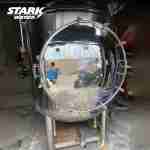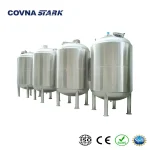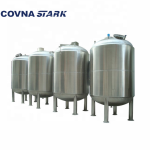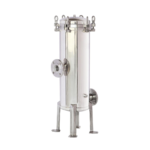Introduction: Why Pressure Tanks Matter in Industrial Water Systems
When designing an industrial water treatment system, most engineers focus on flow rates, filtration units, and pump capacity. However, one critical component is often overlooked or underestimated: the pressure tank. Many assume that a large storage tank alone is enough to stabilize water supply. In reality, a well-sized pressure tank plays a vital role in ensuring consistent pressure, protecting pumps, and improving system efficiency.
Pressure tanks act as hydraulic buffers, absorbing pressure fluctuations and reducing pump cycling. In systems such as reverse osmosis (RO), boiler feedwater supply, chemical dosing, or industrial rinse cycles, even minor pressure instability can lead to membrane damage, poor flow regulation, or frequent system shutdowns.
This article will guide you through the fundamentals of how pressure tanks work, key sizing principles, common selection mistakes, and how to match the right pressure tank to your system needs. Whether you're managing a small RO setup or a high-capacity industrial line, correct pressure tank design can significantly reduce maintenance costs and extend equipment life.
What Is a Pressure Tank and How It Works
A pressure tank is a vessel designed to store water under pressure and regulate the flow and pressure stability in a hydraulic system. Unlike a standard storage tank that simply holds volume, a pressure tank contains a compressed air section that acts as a cushion to absorb pressure fluctuations. This prevents rapid on-off cycles of pumps and ensures smooth water delivery throughout the system.
When the pump starts, it fills the tank with water, compressing the air chamber. As demand increases, the compressed air pushes the water out without requiring the pump to activate immediately. This buffering effect reduces mechanical wear, lowers energy consumption, and protects sensitive equipment downstream—especially in systems with variable demand.
Common Pressure Tank Types:
- Bladder Tank: Features a replaceable rubber bladder that separates water from the compressed air. Ideal for systems requiring hygiene and easy maintenance.
- Diaphragm Tank: Uses a fixed membrane to separate water and air. More compact and common in residential or light commercial applications.
- Plain Air-over-Water Tank: No internal separator; air and water mix directly. Low cost but requires frequent air recharging and is prone to waterlogging.
In industrial applications, bladder and diaphragm tanks are the most reliable choices. They provide stable performance, are easy to maintain, and support a wide range of pressure settings. STARK offers pressure tanks in vertical and horizontal formats, constructed from stainless steel, carbon steel with epoxy lining, or composite materials, depending on your application requirements.
Key Factors When Sizing a Pressure Tank
Correctly sizing a pressure tank is essential to ensure system stability, reduce pump wear, and avoid water hammer or pressure drops. An undersized tank will cause frequent pump cycling, while an oversized tank increases cost and footprint unnecessarily. Here are the key factors to consider when selecting the right tank volume for your industrial application:
1. System Flow Rate
Determine the average and peak flow rate (in L/min or m³/h). This affects how much water needs to be buffered during each pump cycle.
2. Pump Cycle Frequency
Define the minimum time between pump starts (e.g., 30–60 seconds) to reduce motor wear. Shorter cycles require larger buffer volumes.
3. Pressure Settings
Identify the cut-in and cut-out pressure points on your pressure switch or VFD controller. The greater the pressure differential, the more usable volume you get from the tank.
4. Operating Pressure
Check the system’s maximum working pressure. Your tank must be rated above this value, typically with a safety margin (e.g., 1.5x).
5. Usable Drawdown Volume
Not all of the tank volume is usable. Depending on pressure range and tank type, only 25–40% of the total volume is typically available during one pump cycle.
Basic Sizing Formula:
V = (Q × T) / (P1 – P2) × C
Where:
V = Tank volume (L)
Q = Flow rate (L/min)
T = Desired run time (min)
P1 = Cut-out pressure (bar)
P2 = Cut-in pressure (bar)
C = Conversion factor (based on tank type)
Tip: For RO systems or dosing lines, always include a pressure tank to prevent TDS fluctuation, membrane shock, or overdosing. STARK’s team can assist with precise tank sizing based on your process requirements and pressure control logic.
Horizontal vs. Vertical Pressure Tanks: Which to Choose?
Choosing between a horizontal and vertical pressure tank isn’t just about available space—it affects installation, stability, maintenance, and integration with other equipment. Here’s how to decide which orientation fits your application:
Vertical Pressure Tanks
- Space Saving: Ideal for compact plant rooms or where floor area is limited.
- Natural Drainage: Easier to fully drain and clean due to gravity alignment.
- Common in: RO systems, pump stations, pressure boosting setups.
Horizontal Pressure Tanks
- Stability: More stable in mobile skids or where seismic risk exists.
- Better for Skid Integration: Easier to mount beside pumps or beneath pipe manifolds.
- Common in: Containerized systems, mobile RO units, chemical batching setups.
STARK offers both horizontal and vertical pressure tanks in multiple materials and sizes. Optional features include manways, pressure gauges, drain ports, and customizable connection nozzles to suit your piping orientation and system layout.
Matching a Pressure Tank to Your RO System
Reverse Osmosis (RO) systems are particularly sensitive to pressure fluctuations. Without proper pressure buffering, membrane performance degrades, water quality fluctuates, and pump cycles become inefficient. A correctly sized pressure tank is essential to maintain stable inlet pressure, reduce TDS spikes, and extend membrane lifespan.
Common RO System Issues Without a Pressure Tank:
- Pump short cycling: Membrane feed pumps constantly start and stop, causing mechanical wear and energy waste
- Pressure drops at startup: Leads to incomplete membrane wetting and reduced rejection rate
- TDS surge: Sudden changes in pressure cause product water quality to spike temporarily
Integrating a pressure tank before or after the RO unit helps regulate flow and maintain steady pressure across the membranes. It also acts as a buffer against demand surges or valve switching.
STARK Recommendations:
- RO systems up to 1,000 LPH: Use a 100–200L pressure tank to stabilize inlet pressure and reduce pump cycling
- Systems 3–5 m³/h: Consider 300–500L vertical tanks with pre-charged diaphragms
- High-flow RO lines (10 m³/h+): Install multiple pressure tanks in parallel (e.g., 2 × 500L) with balancing valves
STARK offers RO-compatible pressure tanks with anti-corrosion linings, food-grade bladders, and inlet/outlet ports tailored to membrane systems. Our engineering team can also provide matching skid layouts and hydraulic drawings for RO tank integration.
Recommended Sizing Examples
To help you better understand how pressure tank sizing works in real-world scenarios, here are three examples based on common industrial applications. These recommendations are based on STARK’s experience across hundreds of installations and can be adapted to your specific system layout.
1. Small Commercial RO System (500–1,000 LPH)
- Application: Laboratory, bottled water, or restaurant use
- Recommended Tank Size: 100–200 liters
- Orientation: Vertical, compact footprint
- Material: Composite or 304 stainless steel
- Goal: Prevent frequent pump starts, stabilize RO feed pressure
2. Medium-Sized Beverage Plant (3–5 m³/h)
- Application: Juice blending, rinse water, process feed
- Recommended Tank Size: 300–500 liters
- Orientation: Vertical or horizontal (based on pump layout)
- Material: SUS316L with food-grade bladder
- Goal: Reduce pump wear, ensure flow stability during batching
3. Industrial RO Line (10–20 m³/h)
- Application: Factory utility water, cooling systems, EDI pre-treatment
- Recommended Tank Size: 2 × 500L or 1,000–1,500L in parallel
- Orientation: Horizontal for skid mounting
- Material: Carbon steel with epoxy lining or duplex stainless steel
- Goal: Manage large volume fluctuations, dampen pressure spikes
STARK provides technical drawing support, sizing tools, and real-time assistance to help you select the right pressure tank for your specific system. Whether you're designing a compact RO unit or a large-scale utility system, our engineering team ensures the tank fits functionally and physically.
Conclusion – Size It Right, Save Time and Cost
Pressure tanks are often underestimated, yet they play a critical role in industrial water system performance. From stabilizing RO feed pressure to protecting pumps and ensuring smooth water delivery, the right pressure tank helps prevent common issues like short cycling, water hammer, and quality fluctuations.
Correctly sizing and selecting a pressure tank ensures lower maintenance costs, fewer system shutdowns, and longer equipment lifespan. It also improves energy efficiency and supports consistent process control—especially in sensitive applications like food, pharma, and high-purity water systems.
At STARK, we provide pressure tanks from 50L to 2,000L+ in vertical or horizontal configurations. Our tanks are available in 316L stainless steel, carbon steel with internal linings, or composite materials, and can be equipped with food-grade bladders, pressure gauges, inspection ports, and custom connections.
Need help sizing a pressure tank for your system?
Contact the STARK engineering team
for drawings, recommendations, or a tailored quote based on your project specifications.





